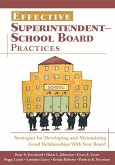- Broschiertes Buch
- Merkliste
- Auf die Merkliste
- Bewerten Bewerten
- Teilen
- Produkt teilen
- Produkterinnerung
- Produkterinnerung
This book focuses on practical strategies and contains comprehensive coverage about most of the areas needing the most focus for superintendents new to their positions
Andere Kunden interessierten sich auch für
![So Now You're the Superintendent! So Now You're the Superintendent!]() John EllerSo Now You're the Superintendent!91,99 €
John EllerSo Now You're the Superintendent!91,99 €![You Have to Go to School - You're the Principal! You Have to Go to School - You're the Principal!]() Paul G. YoungYou Have to Go to School - You're the Principal!85,99 €
Paul G. YoungYou Have to Go to School - You're the Principal!85,99 €![You Have to Go to School - You're the Principal! You Have to Go to School - You're the Principal!]() Paul YoungYou Have to Go to School - You're the Principal!43,99 €
Paul YoungYou Have to Go to School - You're the Principal!43,99 €![The Superintendent as CEO The Superintendent as CEO]() John R HoyleThe Superintendent as CEO97,99 €
John R HoyleThe Superintendent as CEO97,99 €![Passing the Superintendent TExES Exam Passing the Superintendent TExES Exam]() Elaine L. WilmorePassing the Superintendent TExES Exam44,99 €
Elaine L. WilmorePassing the Superintendent TExES Exam44,99 €![Effective Superintendent-School Board Practices Effective Superintendent-School Board Practices]() Rene S. TownsendEffective Superintendent-School Board Practices35,99 €
Rene S. TownsendEffective Superintendent-School Board Practices35,99 €![Superintendent Leadership Superintendent Leadership]() Elaine L. WilmoreSuperintendent Leadership70,99 €
Elaine L. WilmoreSuperintendent Leadership70,99 €-
-
-
This book focuses on practical strategies and contains comprehensive coverage about most of the areas needing the most focus for superintendents new to their positions
Hinweis: Dieser Artikel kann nur an eine deutsche Lieferadresse ausgeliefert werden.
Hinweis: Dieser Artikel kann nur an eine deutsche Lieferadresse ausgeliefert werden.
Produktdetails
- Produktdetails
- Verlag: Corwin
- Seitenzahl: 242
- Erscheinungstermin: 1. November 2008
- Englisch
- Abmessung: 254mm x 178mm x 13mm
- Gewicht: 463g
- ISBN-13: 9781412941723
- ISBN-10: 1412941725
- Artikelnr.: 25052476
- Herstellerkennzeichnung
- Produktsicherheitsverantwortliche/r
- Europaallee 1
- 36244 Bad Hersfeld
- gpsr@libri.de
- Verlag: Corwin
- Seitenzahl: 242
- Erscheinungstermin: 1. November 2008
- Englisch
- Abmessung: 254mm x 178mm x 13mm
- Gewicht: 463g
- ISBN-13: 9781412941723
- ISBN-10: 1412941725
- Artikelnr.: 25052476
- Herstellerkennzeichnung
- Produktsicherheitsverantwortliche/r
- Europaallee 1
- 36244 Bad Hersfeld
- gpsr@libri.de
John Eller has had a variety of experiences in working with adults over the years he has been in education. His experiences include work educational leaders at Virginia Tech University, developing teacher leaders in a Maters program, serving as the Executive Director of Minnesota ASCD, work as a principal's training center director, a position as an assistant superintendent for curriculum, learning, and staff development, and several principal positions in a variety of settings. In addition to the work he does in training and supporting facilitators, John also does work in the areas of dealing with difficult people, building professional learning communities, employee evaluation, conferencing skills, coaching skills, strategic planning strategies, school improvement planning and implementation, differentiated instruction, leadership for differentiation, employee recruitment, selection, and induction, supervisory skills, and effective teaching strategies. He has his PhD. in Educational Leadership and Policy Studies from Loyola University-Chicago and his MS in Educational Leadership from the University of Nebraska-Omaha. John has authored books on substitute teaching, wrote The Training Video Series for the Professional School Bus Driver, The principals' Guide to Custodial Supervision contributes articles for the publication Superintendents Only. He wrote Effective Group Facilitation in Education: How to Energize Meetings and Manage Difficult Groups, and co-authored So Now You're the Superintendent, the best selling, Energizing Staff Meetings and Creative Strategies to Improve School Culture all through Corwin Press.
Preface Acknowledgments About the Authors 1. My Office Key Works, What
s Next? About This Chapter The Superintendency: Understanding the Historical Context Potential Pitfalls for New Superintendents Challenges of Leading a School District The Importance of Focusing on the "Big Picture" Jockeying for Position The Windowpane Model: A Tool for Analyzing and Understaning Constituent Perspectives The Superintendent as Community Liaison Develop a Key Communicators Listing The Changing Role of the Superintendency Navigating the Changing Landscape Successful School Change Hills to "Die On" Successful Communicator Summary 2. The Superintendent-School Board Relationship: A Cornerstone of Your Success About This Chapter Managing the Superintendent-Board Relationship The Importance of Equal Treatment The "Inner Circle" Addressing Individual Board Member Requests When Is Equal Treatment Unequal? Superintendent-Board Chair/President Interaction Establishing Superintendent-Board Chair/President Interaction Norms Keeping the Chair/President Relationship Productive The Basics of Board Communication Successful Communication: Form and Frequency Forms of Communication A Special Note About E-Mail Communication Frequency of Communication Establishing Effective Superintendent-Board Chair/President Communication Emergency Communication Standards Maintenance of Your Communication Plan With the Board Board Standards and Operating Protocols Who Has Authority for What: The Board and Superintendent as a Team Summary 3. Organizational Trust and Culture: What Every Superintendent Should Know About This Chapter Organizational Culture Rapport, Trust, Climate, and Their Relation to Culture The Importance of Trust Building and Sustaining Organizational Trust Organizational Culture: The Gatekeeper of Excellence Properties of School Districts as Organizations The Complexity of Organizations Organizations Are Surprising Organizations Are Deceptive Organizations Are Like Organisms Trust and Excellence in Employee Group/Union Relationships Summary 4. School Finance 101: What Should the Superintendent Know? About This Chapter Staying Afloat: Four Key Financial Reports Enrollment Reports Monthly Enrollment Reports Annual Enrollment Projections Expenditure Reports Key Components and Their Location in the Budget Report Current Budget Current Month
s Expenditures Previous Year
s Budget Data Amount of Money Left in the Current Budget Revenue Reports Staffing Plans/Position Control Systems Long-Range Financial Projection: Your Own Crystal Ball The Importance of Long-Range Projection Understanding the School District
s Financial Audit Summary 5. How to Implement New Ideas in Your Initial Years as Superintendent About This Chapter The Change Process The Honeymoon Period Transitions and the Change Process Levers of Change Frames of Reference Related to the Change Process Strategies to Consider When Dealing With Resistance Facilitating/Guiding Groups Through Change Putting It Behind Us Learning Walk Implementation Blocking Summary 6. Supervising Principals and Directors: Strategies for Success About This Chapter Supervision of Executive-Level Administrators and Principals Getting the Most From Your Staff Members Supervision Strategies for Directors and Department/Divisional Administrators Evaluating Department Heads, Assistant Superintendents, and Directors Goal Setting Summary 7. What About the Students? Instructional Leadership and Dealing With Federal Programs About This Chapter Instructional Leadership No Child Left Behind Act Special Education Summary 8. Dealing With Difficult People and Situations About This Chapter What
s Behind All of This Negative Behavior? Frames of Reference Negative Reinforcement Understanding the Perspectives of Others Types of Conflict Substantive (Cognitive) Conflict Affective (Personality-Based) Conflict Skills for Dealing With Difficult People Temporary Suspension of Opinion Framing Reflecting Skills Implementation Blocking Shifting Energy Focus Design and Implement Positive Problem-Solving Processes Mediating Conflict Working Positively With the Press Summary 9. Getting the Word Out: Effective Communication Strategies About This Chapter The Power of Effective Communication Sticky Note Ripple Effects Managing Information Flow in Your Office and in the District Establishing a Board Communication Process Superintendent to Board Board to Community Community to Board Board to Superintendent Handling Private and Public Data Summary 10. It
s July, Now What? About This Chapter The Importance of an Entry Plan: Successfully Navigating Your First Ninety Days on the Job Opening Day With Staff Selecting a Mentor Key Components for Successful Mentor-Mentee Relationships Sample Calendar of Monthly Events/Activities Summary Key Points From Each Chapter References Index
s Next? About This Chapter The Superintendency: Understanding the Historical Context Potential Pitfalls for New Superintendents Challenges of Leading a School District The Importance of Focusing on the "Big Picture" Jockeying for Position The Windowpane Model: A Tool for Analyzing and Understaning Constituent Perspectives The Superintendent as Community Liaison Develop a Key Communicators Listing The Changing Role of the Superintendency Navigating the Changing Landscape Successful School Change Hills to "Die On" Successful Communicator Summary 2. The Superintendent-School Board Relationship: A Cornerstone of Your Success About This Chapter Managing the Superintendent-Board Relationship The Importance of Equal Treatment The "Inner Circle" Addressing Individual Board Member Requests When Is Equal Treatment Unequal? Superintendent-Board Chair/President Interaction Establishing Superintendent-Board Chair/President Interaction Norms Keeping the Chair/President Relationship Productive The Basics of Board Communication Successful Communication: Form and Frequency Forms of Communication A Special Note About E-Mail Communication Frequency of Communication Establishing Effective Superintendent-Board Chair/President Communication Emergency Communication Standards Maintenance of Your Communication Plan With the Board Board Standards and Operating Protocols Who Has Authority for What: The Board and Superintendent as a Team Summary 3. Organizational Trust and Culture: What Every Superintendent Should Know About This Chapter Organizational Culture Rapport, Trust, Climate, and Their Relation to Culture The Importance of Trust Building and Sustaining Organizational Trust Organizational Culture: The Gatekeeper of Excellence Properties of School Districts as Organizations The Complexity of Organizations Organizations Are Surprising Organizations Are Deceptive Organizations Are Like Organisms Trust and Excellence in Employee Group/Union Relationships Summary 4. School Finance 101: What Should the Superintendent Know? About This Chapter Staying Afloat: Four Key Financial Reports Enrollment Reports Monthly Enrollment Reports Annual Enrollment Projections Expenditure Reports Key Components and Their Location in the Budget Report Current Budget Current Month
s Expenditures Previous Year
s Budget Data Amount of Money Left in the Current Budget Revenue Reports Staffing Plans/Position Control Systems Long-Range Financial Projection: Your Own Crystal Ball The Importance of Long-Range Projection Understanding the School District
s Financial Audit Summary 5. How to Implement New Ideas in Your Initial Years as Superintendent About This Chapter The Change Process The Honeymoon Period Transitions and the Change Process Levers of Change Frames of Reference Related to the Change Process Strategies to Consider When Dealing With Resistance Facilitating/Guiding Groups Through Change Putting It Behind Us Learning Walk Implementation Blocking Summary 6. Supervising Principals and Directors: Strategies for Success About This Chapter Supervision of Executive-Level Administrators and Principals Getting the Most From Your Staff Members Supervision Strategies for Directors and Department/Divisional Administrators Evaluating Department Heads, Assistant Superintendents, and Directors Goal Setting Summary 7. What About the Students? Instructional Leadership and Dealing With Federal Programs About This Chapter Instructional Leadership No Child Left Behind Act Special Education Summary 8. Dealing With Difficult People and Situations About This Chapter What
s Behind All of This Negative Behavior? Frames of Reference Negative Reinforcement Understanding the Perspectives of Others Types of Conflict Substantive (Cognitive) Conflict Affective (Personality-Based) Conflict Skills for Dealing With Difficult People Temporary Suspension of Opinion Framing Reflecting Skills Implementation Blocking Shifting Energy Focus Design and Implement Positive Problem-Solving Processes Mediating Conflict Working Positively With the Press Summary 9. Getting the Word Out: Effective Communication Strategies About This Chapter The Power of Effective Communication Sticky Note Ripple Effects Managing Information Flow in Your Office and in the District Establishing a Board Communication Process Superintendent to Board Board to Community Community to Board Board to Superintendent Handling Private and Public Data Summary 10. It
s July, Now What? About This Chapter The Importance of an Entry Plan: Successfully Navigating Your First Ninety Days on the Job Opening Day With Staff Selecting a Mentor Key Components for Successful Mentor-Mentee Relationships Sample Calendar of Monthly Events/Activities Summary Key Points From Each Chapter References Index
Preface Acknowledgments About the Authors 1. My Office Key Works, What
s Next? About This Chapter The Superintendency: Understanding the Historical Context Potential Pitfalls for New Superintendents Challenges of Leading a School District The Importance of Focusing on the "Big Picture" Jockeying for Position The Windowpane Model: A Tool for Analyzing and Understaning Constituent Perspectives The Superintendent as Community Liaison Develop a Key Communicators Listing The Changing Role of the Superintendency Navigating the Changing Landscape Successful School Change Hills to "Die On" Successful Communicator Summary 2. The Superintendent-School Board Relationship: A Cornerstone of Your Success About This Chapter Managing the Superintendent-Board Relationship The Importance of Equal Treatment The "Inner Circle" Addressing Individual Board Member Requests When Is Equal Treatment Unequal? Superintendent-Board Chair/President Interaction Establishing Superintendent-Board Chair/President Interaction Norms Keeping the Chair/President Relationship Productive The Basics of Board Communication Successful Communication: Form and Frequency Forms of Communication A Special Note About E-Mail Communication Frequency of Communication Establishing Effective Superintendent-Board Chair/President Communication Emergency Communication Standards Maintenance of Your Communication Plan With the Board Board Standards and Operating Protocols Who Has Authority for What: The Board and Superintendent as a Team Summary 3. Organizational Trust and Culture: What Every Superintendent Should Know About This Chapter Organizational Culture Rapport, Trust, Climate, and Their Relation to Culture The Importance of Trust Building and Sustaining Organizational Trust Organizational Culture: The Gatekeeper of Excellence Properties of School Districts as Organizations The Complexity of Organizations Organizations Are Surprising Organizations Are Deceptive Organizations Are Like Organisms Trust and Excellence in Employee Group/Union Relationships Summary 4. School Finance 101: What Should the Superintendent Know? About This Chapter Staying Afloat: Four Key Financial Reports Enrollment Reports Monthly Enrollment Reports Annual Enrollment Projections Expenditure Reports Key Components and Their Location in the Budget Report Current Budget Current Month
s Expenditures Previous Year
s Budget Data Amount of Money Left in the Current Budget Revenue Reports Staffing Plans/Position Control Systems Long-Range Financial Projection: Your Own Crystal Ball The Importance of Long-Range Projection Understanding the School District
s Financial Audit Summary 5. How to Implement New Ideas in Your Initial Years as Superintendent About This Chapter The Change Process The Honeymoon Period Transitions and the Change Process Levers of Change Frames of Reference Related to the Change Process Strategies to Consider When Dealing With Resistance Facilitating/Guiding Groups Through Change Putting It Behind Us Learning Walk Implementation Blocking Summary 6. Supervising Principals and Directors: Strategies for Success About This Chapter Supervision of Executive-Level Administrators and Principals Getting the Most From Your Staff Members Supervision Strategies for Directors and Department/Divisional Administrators Evaluating Department Heads, Assistant Superintendents, and Directors Goal Setting Summary 7. What About the Students? Instructional Leadership and Dealing With Federal Programs About This Chapter Instructional Leadership No Child Left Behind Act Special Education Summary 8. Dealing With Difficult People and Situations About This Chapter What
s Behind All of This Negative Behavior? Frames of Reference Negative Reinforcement Understanding the Perspectives of Others Types of Conflict Substantive (Cognitive) Conflict Affective (Personality-Based) Conflict Skills for Dealing With Difficult People Temporary Suspension of Opinion Framing Reflecting Skills Implementation Blocking Shifting Energy Focus Design and Implement Positive Problem-Solving Processes Mediating Conflict Working Positively With the Press Summary 9. Getting the Word Out: Effective Communication Strategies About This Chapter The Power of Effective Communication Sticky Note Ripple Effects Managing Information Flow in Your Office and in the District Establishing a Board Communication Process Superintendent to Board Board to Community Community to Board Board to Superintendent Handling Private and Public Data Summary 10. It
s July, Now What? About This Chapter The Importance of an Entry Plan: Successfully Navigating Your First Ninety Days on the Job Opening Day With Staff Selecting a Mentor Key Components for Successful Mentor-Mentee Relationships Sample Calendar of Monthly Events/Activities Summary Key Points From Each Chapter References Index
s Next? About This Chapter The Superintendency: Understanding the Historical Context Potential Pitfalls for New Superintendents Challenges of Leading a School District The Importance of Focusing on the "Big Picture" Jockeying for Position The Windowpane Model: A Tool for Analyzing and Understaning Constituent Perspectives The Superintendent as Community Liaison Develop a Key Communicators Listing The Changing Role of the Superintendency Navigating the Changing Landscape Successful School Change Hills to "Die On" Successful Communicator Summary 2. The Superintendent-School Board Relationship: A Cornerstone of Your Success About This Chapter Managing the Superintendent-Board Relationship The Importance of Equal Treatment The "Inner Circle" Addressing Individual Board Member Requests When Is Equal Treatment Unequal? Superintendent-Board Chair/President Interaction Establishing Superintendent-Board Chair/President Interaction Norms Keeping the Chair/President Relationship Productive The Basics of Board Communication Successful Communication: Form and Frequency Forms of Communication A Special Note About E-Mail Communication Frequency of Communication Establishing Effective Superintendent-Board Chair/President Communication Emergency Communication Standards Maintenance of Your Communication Plan With the Board Board Standards and Operating Protocols Who Has Authority for What: The Board and Superintendent as a Team Summary 3. Organizational Trust and Culture: What Every Superintendent Should Know About This Chapter Organizational Culture Rapport, Trust, Climate, and Their Relation to Culture The Importance of Trust Building and Sustaining Organizational Trust Organizational Culture: The Gatekeeper of Excellence Properties of School Districts as Organizations The Complexity of Organizations Organizations Are Surprising Organizations Are Deceptive Organizations Are Like Organisms Trust and Excellence in Employee Group/Union Relationships Summary 4. School Finance 101: What Should the Superintendent Know? About This Chapter Staying Afloat: Four Key Financial Reports Enrollment Reports Monthly Enrollment Reports Annual Enrollment Projections Expenditure Reports Key Components and Their Location in the Budget Report Current Budget Current Month
s Expenditures Previous Year
s Budget Data Amount of Money Left in the Current Budget Revenue Reports Staffing Plans/Position Control Systems Long-Range Financial Projection: Your Own Crystal Ball The Importance of Long-Range Projection Understanding the School District
s Financial Audit Summary 5. How to Implement New Ideas in Your Initial Years as Superintendent About This Chapter The Change Process The Honeymoon Period Transitions and the Change Process Levers of Change Frames of Reference Related to the Change Process Strategies to Consider When Dealing With Resistance Facilitating/Guiding Groups Through Change Putting It Behind Us Learning Walk Implementation Blocking Summary 6. Supervising Principals and Directors: Strategies for Success About This Chapter Supervision of Executive-Level Administrators and Principals Getting the Most From Your Staff Members Supervision Strategies for Directors and Department/Divisional Administrators Evaluating Department Heads, Assistant Superintendents, and Directors Goal Setting Summary 7. What About the Students? Instructional Leadership and Dealing With Federal Programs About This Chapter Instructional Leadership No Child Left Behind Act Special Education Summary 8. Dealing With Difficult People and Situations About This Chapter What
s Behind All of This Negative Behavior? Frames of Reference Negative Reinforcement Understanding the Perspectives of Others Types of Conflict Substantive (Cognitive) Conflict Affective (Personality-Based) Conflict Skills for Dealing With Difficult People Temporary Suspension of Opinion Framing Reflecting Skills Implementation Blocking Shifting Energy Focus Design and Implement Positive Problem-Solving Processes Mediating Conflict Working Positively With the Press Summary 9. Getting the Word Out: Effective Communication Strategies About This Chapter The Power of Effective Communication Sticky Note Ripple Effects Managing Information Flow in Your Office and in the District Establishing a Board Communication Process Superintendent to Board Board to Community Community to Board Board to Superintendent Handling Private and Public Data Summary 10. It
s July, Now What? About This Chapter The Importance of an Entry Plan: Successfully Navigating Your First Ninety Days on the Job Opening Day With Staff Selecting a Mentor Key Components for Successful Mentor-Mentee Relationships Sample Calendar of Monthly Events/Activities Summary Key Points From Each Chapter References Index








